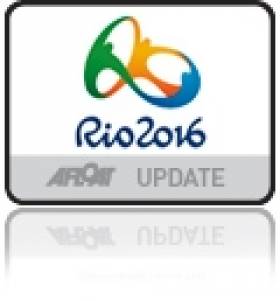Displaying items by tag: Road to Rio
Drea Helps Young People Complete Road to Rio
#Rowing: The Road to Rio row came to a spirited conclusion in Parliament Square at Trinity College today. Ireland Olympians Sean Drea and Brendan Dolan and Eimear Lambe, younger sister of soon-to-be Olympian Claire, were among those taking part in the final push. Ministers Michael Noonan and Frances Fitzgerald visited the stand. Thousands of young people had done stints on ergometers, with the distances they covered counted off the 9195.97 kilometres from Ireland to Rio de Janeiro.
#swchyeres – After missing the gold fleet cut at both Miami and Palma ISAF World Cup regattas this year, Ireland's Olympic sailor Annalise Murphy showed the depth of her ambition in France this afternoon when she opened her Laser Radial account at the final round of ISAF's World Cup in Hyeres with a race win and a third place to lie just two nett points off the overall lead after the first three races.
After a fantastic day afloat in consistent 15–knot breezes, Annalise lies second overall tonight to Belgium's Evi Van Acker tonight and except for a slip in race two might well be heading up her 79–boat fleet. The Dubliner shares the same four points as the Belarussian Tatiana Drozdovskaya with only seven seven points separating the top ten.
Murphy was as far back as 28th after counting a 27th in race two but bounced straight back with a third in race three to be right in the frame in the early part of this qualification round.
It was a significant performance in the more than forecasted winds and in a fleet that contains the very best sailors in the world including two of the three London 2012 Olympic medallists. Results here.
Tweeting after coming ashore, Murphy told her followers: "I had a 1st, a shocker of a 27th and a 3rd today which should put me into third overall. Significant improvement from Palma!"
Van Acker looked to banish her Palma demons as she took two race wins and a fifth to lead in Hyères. The Belgian racer missed out on a podium spot at ISAF Sailing World Cup Mallorca as she engaged in a battle for silver with Tuula Tenkanen (FIN) in the Medal Race. She finished the Medal Race in 10th and fell to fourth, missing out on a medal. A strong performance in the Hyères has put her on the right route at the early stage of the event.
ISAF Sailing World Cup Melbourne gold medallist Tatiana Drozdovskaya (BLR) is third overall.
A confirmed number of 1,111 sailors racing in 765 boats from 59 nations are racing on the French Gold coast in what is a massive turnout to bring the ISAF Sailing World Cup series to a close.
In other Irish sailing team news from Hyeres, Murphy's London 2012 team–mates have also opened their French accounts each sailing three races today.
In the mens 49er skiff class Ryan Seaton and Matt McGovern are highly placed in tenth overall in the 79 boat fleet after scoring 3,6 and 7. Results here.
ISAF Sailing World Cup Mallorca gold medallists Martine Grael and Kahena Kunze (BRA) got their week off to a strong start after picking up two race wins and discarding a 14th.
The Brazilians are in familiar company atop of the leader board with many of the leading 49erFX sailors trailing them by a narrow margin.
Ida Marie Baad Nielsen and Marie Thusgaard Olsen (DEN) sit two points behind the Brazilians whilst Charlotte Dobson and Sophie Ainsworth (GBR), who took the days other race win, occupy third.
2013 World Champions and defending Hyères champions Alex Maloney and Molly Meech (NZL) found their form after a disappointing week in Mallorca. Recording a second, a discarded 19th and a third they sit in fourth.
James Espey lies 70th from 123 starters in the mens Laser division. Results here. Jean Baptiste Bernaz (FRA) took two race wins in the Laser and is the early leader in the 123-boat fleet. The French racer took two bullets from the day's opening encounters and came through with a ninth in the third and final race of the opening day.
With two fleets the remaining race victories went the way of Robert Scheidt (BRA), Jesper Stalheim (SWE), Andy Maloney (NZL) and Matt Wearn (AUS).
Ireland's Andrea Brewster and Saskia Tidey are 17th from 42 in the womens 49erfx skiff. Results here.






























































